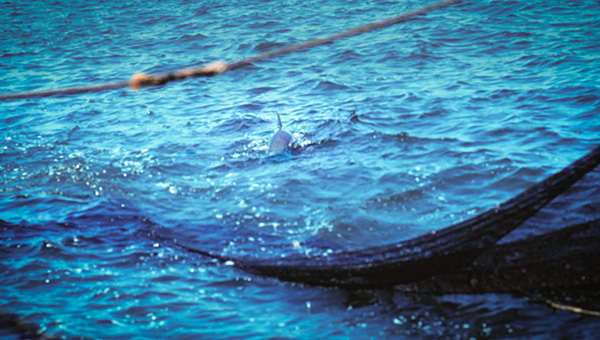Food Preferences & Resources
Dolphins are active predators and eat a wide variety of fishes, squids, and crustaceans such as shrimps. The foods available to a dolphin vary with its geographic location.
Dolphins show strong preferences for certain species of food fish.
- Coastal dolphins tend to eat fishes and bottom-dwelling invertebrates.
- Offshore dolphins tend to eat fishes and squid.
- Some offshore dolphins were found with deep-sea fishes in their stomachs. This evidence suggests that offshore dolphins may dive to more than 500 m (1,600 ft.).
Food Intake
Adult bottlenose dolphins eat approximately 4% to 6% of their body weight in food per day. A nursing mother's daily intake is considerably higher — about 8%.
A dolphin's stomach is compartmentalized for rapid digestion.

Methods of Collecting and Eating Food
Feeding behavior is flexible and adapted to a dolphin's particular habitat and available food resources.
Hunting strategies are varied and diverse.
- Bottlenose dolphins often cooperate when hunting and catching fish.
- In open waters, a dolphin group sometimes encircles a large school of fish and herds the fish into a small, dense mass. The dolphins take turns charging through the school to feed.
- Near the surface of the ocean, dolphins at Sarasota Bay, Florida, may roll to their sides with one pectoral flipper raised high. The dolphins encircle a school of fish, splashing their tail flukes and forcing them to bunch in a tighter and tighter group until the dolphins turn to grab a quick meal on the go. This hunting technique is referred to as "pinwheeling".
- "Drivers and blockers" is a rare example of an animal hunting technique that demonstrates a clear division of labor. While hunting fish, some of these highly specialized groups are "divers" who smack the water's surface with their tail flukes to herd fish into a circle. Others stay less than a body length apart from each other to block and prevent fish from escaping. This technique has been documented in bottlenose dolphins off the waters of Cedar Key, Florida.
- Occasionally dolphins herd schools of fish against sand bars, shorelines, or mud banks to trap them in shallow water where the fish are easy prey. This hunting technique is referred to as “strand feeding”.
- Dolphins also feed on individual, nonschooling fishes.
- A bottlenose dolphin may use its tail flukes to flip a fish out of the water, and then retrieve the stunned prey.
- During the hunting technique known as "crater feeding," bottlenose dolphins dive snout-first into the sandy bottom trying to grab an unsuspecting fish. This technique got its name because of the craters the dolphins left behind in the sand.
- Some coastal bottlenose dolphins in Shark Bay, Western Australia seem to use a certain species of sponge (Echinodictyum mesenterium) as a shield when foraging in areas with rocky or sandy bottoms.
- Researchers have observed a small number of females carrying the sponges on their beaks, diving down, and then dropping the sponge just prior to surfacing and swallowing prey. Researchers theorize that the sponge acts as a shield to protect the dolphin's beak (rostrum) from spines of certain fishes or stingrays, or from sharp shells or rocks when the dolphin digs into sandy-bottomed habitats in search of prey. This sponge-carrying tool-use behavior has only been seen in several female dolphins and some of their female offspring at Shark Bay.
- In a behavior termed "kerplunking," bottlenose dolphins foraging in shallow sea grass beds in Australia and Florida, slap the water's surface with their lower body and flukes creating a splash of bubbles to startle fishes out of hiding and make them easier to catch.
- Once mullets enter shallow water off the west coast of Florida, dolphins swim around them while hitting the ocean floor with their tail flukes. This creates a ring of mud which surrounds the fish. In a panic the fish leap up into the air...and into the mouths of the dolphins.
- Bottlenose dolphins often feed in association with fishing operations. Dolphins may accompany shrimp trawls or other fishing vessels and feed on discarded fishes caught incidentally in the nets.

Dolphins do not chew their food. Before eating large fishes, bottlenose dolphins shake them or rub them on the ocean floor until suitable-size pieces break off. They also strip meat from spiny fishes, reducing the chance of injury from sharp spines.



